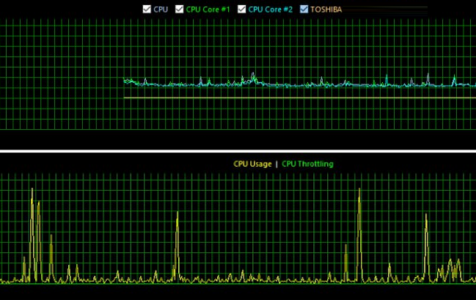For computing enthusiasts, gamers, and professionals, understanding the normal idle temperature for a CPU is crucial for system efficiency and health. Whether you’re new to computing or seeking insights into what temperature should your CPU be at idle, this guide offers comprehensive information to clarify your doubts.
What Exactly Is Idle CPU Temperature?
Idle CPU temperature refers to the heat measured from your processor when your computer is turned on but not engaged in heavy processing tasks. When you’re reading emails or writing a document, your CPU isn’t strained much, and hence, the temperature should be at its lowest.
Safe Ranges for Idle CPU Temperature
Determining a good idle temperature for your CPU depends on its make and model, but generally, a normal CPU temperature while idle is between 30–40 degrees Celsius (86–104 degrees Fahrenheit). If your CPU’s idle temperatures exceed these averages, it’s advisable to investigate further.
In exploring the significance of idle CPU temperatures for computing enthusiasts, gamers, and professionals, it’s important to consider various benchmarks and recommendations from expert sources. Idle CPU temperature, which is the heat measured from the processor when the computer is not engaged in heavy tasks, varies depending on several factors like CPU type, cooling systems, and ambient conditions.
| CPU Type | Idle Temperature Range (°C) | Idle Temperature Range (°F) | Additional Notes |
|---|---|---|---|
| Desktop | 35 - 50 | 95 - 122 | Above 65°C (149°F) is high for desktop CPUs |
| Laptop | 45 - 55 | 113 - 131 | Above 75°C (167°F) is high for laptop CPUs |
| Intel/AMD Desktop | 45 - 50 | 95 - 122 | Up to 80°C (176°F) when gaming at max load |
Factors Influencing CPU Temperatures
Various factors can influence your CPU’s idle temperatures, such as an overworked CPU, inefficient cooling, or poor ventilation. Understanding what the idle temperature of your CPU should be and monitoring for any deviations from the average CPU temperature at idle (30–40°C) is essential.
Persistent high temperatures could potentially lead to hardware damage. By maintaining ideal temperatures, components can perform optimally for longer while also preventing thermal throttling—a protection mechanism that reduces CPU performance to avoid overheating.
Balancing Act: Cooling Systems and Environment
Excellent airflow within your PC case is a starting point for good temperature management. Adding more fans or upgrading existing ones aids in this effort. Keeping your system clean and free from dust is equally vital; blocked vents and fans curtail airflow, causing increased temperatures.
Room temperature plays a role too. A hot environment can thwart even the best cooling systems, shortening the temperature headroom for your CPU. That’s why ambient temperature—temperature surrounding your system—is often factored into temperature norms.
Tools to Monitor CPU Temperature
Keeping tabs on your CPU is made easy with tools like HWMonitor, Camomile, Core Temp, or SpeedFan. These programs offer real-time insight into your CPU’s temperatures, empowering swift action to prevent potential overheating during more demanding tasks like gaming.
In the PC-building community, such as that seen on Reddit’s r/buildapc forum, discussions about CPU temperatures are common. Enthusiasts share their experiences on this topic, providing real-world insight that complements theoretical knowledge. To see these discussions for yourself and join in, visit the r/buildapc subreddit.
Addressing High Idle CPU Temperatures
If you find that your CPU’s temperatures are higher than ideal, it’s time for some troubleshooting. Reseating your CPU cooler, applying fresh thermal paste, or even upgrading your cooler altogether can all make a significant difference.
For those who have overclocked their system, keep in mind that although it bolsters CPU performance, it also increases heat output. Fine-tuning the voltage and clock speed, or improving the cooling setup, might be necessary to balance performance and heat.
Acting on Temperature Readings: When to Be Concerned
While idle temperatures aren’t the sole determinant of CPU health, they’re an excellent indication of how hard your cooling systems will need to work when the CPU is under load. Boiling it down, the lower the temperature, the more headroom you have for intense processing tasks before hitting critical temperature peaks.
Now, if you’ve got your gear all set up and wonder about the normal CPU temps in BIOS upon startup, remember that these can vary based on the CPU model and your specific cooling system. However, anything between 30–50°C is quite common for most CPUs in idle conditions.
Wrapping It Up
Knowing what’s normal for CPU temperature isn’t just for computing aficionados—it’s a vital aspect of looking after your PC. By maintaining appropriate temperatures, you’re ensuring a seamless gaming experience, system reliability, and longevity of your CPU. It also allows you to be proactive, making environmental adjustments or considering advanced cooling options to handle the excess heat effectively.
Balancing temperatures is an ongoing task, and every PC setup has its nuances. It’s therefore wise to keep an eye on your CPU temperatures using monitoring software and adjust settings or your system’s cooling solutions as needed. Your diligent attention will help in keeping your computing sessions smooth and components operating within their best parameters.
